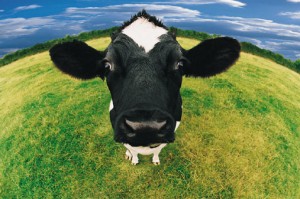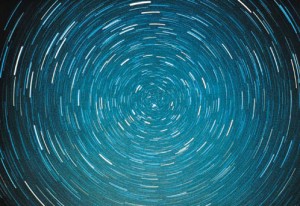Freedom to Question (Part Two)
By Asher Crispe: May 13, 2011: Category Inspirations, Quest of the Question
Famed Noble Laureate Isidor Isaac Rabi once offered the following personal anecdote:
My mother made me a scientist without ever intending to. Every other Jewish mother in Brooklyn would ask her child after school: So? Did you learn anything today? But not my mother. ‘Izzy,’ she would say, ‘did you ask a good question today?’ That difference—asking good questions—made me become a scientist.
—Quoted in “Great Minds Start with Questions,” Parents Magazine (September 1993)
 Could the capacity to question be the human trait that differentiates us from the animal? While it is possible to sense many things when staring into the eyes of an animal, I have never known anyone claim that the animal was in a state of existential crisis. Having grown up in rural Vermont, I was afforded many opportunities to stare down all sorts of creatures. My experience after a prolonged gaze into the eyes of a cow never led me to believe that the cow was wondering why it was not born a horse or a chicken or even a human for that matter. Nor did I for a moment register in any of our bovine friends the desire to be all the cow that it could be, to reach for transcendental cow-ness, to aspire to live the life of the Über-cow.
Could the capacity to question be the human trait that differentiates us from the animal? While it is possible to sense many things when staring into the eyes of an animal, I have never known anyone claim that the animal was in a state of existential crisis. Having grown up in rural Vermont, I was afforded many opportunities to stare down all sorts of creatures. My experience after a prolonged gaze into the eyes of a cow never led me to believe that the cow was wondering why it was not born a horse or a chicken or even a human for that matter. Nor did I for a moment register in any of our bovine friends the desire to be all the cow that it could be, to reach for transcendental cow-ness, to aspire to live the life of the Über-cow.
The psychology of the animal is driven by habit and instinct. By failing to enter into an advanced state of self-conscious reflection, the quality of creature consciousness expresses itself as a kind of passive acceptance of its nature. Animals represent self-sameness. A cow is a cow is a cow. They are always more or less equal to themselves.
In Kabbalah, the state-of-being-animal is a universal tendency within Creation. When the nature of nature is to conform to an invariant model, then nature itself may be symbolized as one great animal or behaimah rabbah. Furthermore, we encounter the notion that animality signifies one of the fundamental modes of Being. Since the essential name for God (the Tetragrammaton)— the letters of which rearrange to spell havayah—denotes the overall term for Being, it follows in the Jewish mystical tradition that each of the four letters of this name (yud-hei-vav-hei) have an associate mode of Being attached to it.
The way the Kabbalists explain this notion is as follows:
Every Hebrew letter has one or more possible spellings and these spelling serve to fill out hidden dimensions within a particular letter. So for instance the letter yud is written as a single character (י) but is pronounced y-u-d as though written with three letters (יוד). This is the one and only ‘filling’ in of this letter. The other letters (hei and vav) however, have multiple spellings which encode a subtle mystical symbolism.
Hei (ה) can be written in three ways:
hei-hei (ה-ה)
hei-yud (ה-י)
hei-alef (ה-א)
So too, the letter vav (ו) can be written three different ways:
vav-vav (ו-ו)
vav-yud-vav (ו-י-ו)
vav-alef-vav (ו-א-ו)
How does all of this pertain to the animal realm?
Following from the above spelling possibilities, the kabbalists maintain that if we select the following letter combination and add up the numerical values of those letters: (י-ו-ד) yud = 20 (ה-ה) hei =10 (ו-ו) vav = 12 (ה-ה) hei = 10, the total is equivalent to 52. 52 equals the letters beit (2) and nun (50) in Hebrew. Consequently, this is known as the name Ban (ב”ן beit-nun) or alternatively in some Sephardic traditions it is pronounced Ben as in ‘son’ or ‘child’. However, 52 is also taken to be an illusion to the Hebrew word behaimah (בהמה) meaning animal.
The Chassidic masters point out that, while the first letter (yud) is always the same, the subsequent three letters (hei-vav-hei) each present with three options to choose from. That being said, in the case of the animal or behaimah (=52) the hidden code of expanded letters has the unique feature of being comprised of all double letters. In other words, the original written letter and its spelled out expansion (the way it would be pronounced) are identical. It is as if to say that the sign/letter and the expression of the sign/letter are one and the same. They are self-similar. This repetition of sameness is the prime characteristic of the animal.
Moreover, we can go a step further and assert that the animal is emblematic of nature. Nature requires self-consistency. Consider the Hebrew word for nature—tevah (טבע)—which relates to the word tebat (טבעת) meaning a ring. The circularity of the ring suggests natural cycles which repeat over and over again and thereby become predictable due to their internal consistency and self-sameness. The repetition of the same behavior marks the formation of habits. Perhaps we can even ponder the hamster wheel in this light. Spinning its wheel round and round, the animal never goes anywhere. Its motion is framed within preset parameters that are regulated.
 By extension, if the whole of reality takes on this animality as its mode of being, then the revolving heavenly bodies (from the perspective of an earthbound observer) appear to play out this cyclical pattern in a uniform manner. Once observed, the spell-binding power of invariant properties within nature seem to exclude the possibility of change. We start to take them for granted. We cease to question them. We are pacified by the perception that all natural phenomena seem to be predictable. The cycles, once apprehended, give the impression of returning eternally.
By extension, if the whole of reality takes on this animality as its mode of being, then the revolving heavenly bodies (from the perspective of an earthbound observer) appear to play out this cyclical pattern in a uniform manner. Once observed, the spell-binding power of invariant properties within nature seem to exclude the possibility of change. We start to take them for granted. We cease to question them. We are pacified by the perception that all natural phenomena seem to be predictable. The cycles, once apprehended, give the impression of returning eternally.
And this is not just true of our physical universe. Beyond the ‘cosmic animal’, we rub up against the animal within each and every one of us. Branded the ‘animal soul’ in Chassidic discourses, the behavioral psychology of human beings highlights what we have come to call ‘human nature’ or the relative animal within the human. If our present and future manner of acting conforms to our past, if we are hopelessly predictable, then we feel destined to repeat all over our same successes and mistakes. We tell ourselves: ‘it worked the first time and therefore it must always work again.’ Or on the opposite extreme: ‘I failed the first time, consequently I will always fail.’ From ourselves we can only expect more of the same. This is our inner animal speaking. I am what I am because what I am is what I am. There is no use questioning it.
Now for the bubble bursting. Whether it be the universe or myself, the habits of nature are just that—habits. Ironclad laws force us to surrender all expectation of change but habits can be retrained. We need to look for exceptions. Once spotted, the anomalous opens an opportunity for escape from the repetition of the “same old—same old”. Uncertainly and hidden variables creep into the equations of life, stripping them of their sure-fire accuracy and imperial predictability. Novelty casts a long shadow over our once confident idea that past experience is a guarantee of future experience. Catching site of the variations, of the alterations to nature that knock repetition off its axis, interrupts our complacency with the familiar. Difference solicits the question.
So what are we? The kabbalists point to another mode of being that stands in contrast to animality. Adam or Adom in Hebrew refers to the human condition. Adom (אדם) however, is equivalent of another of the spelling of the Divine name or Tetragrammaton. If we write the letters with the following fillings:
Yud (י-ו-ד)
Hei (ה-א)
Vav (ו-א-ו)
Hei (ה-א)
they add up to 45 which is called the name of Mah (מ”ה). Mah literally means “what” as in the archetypal form of a question—what is x?… Thus humanity (Adom) is itself equivalent to the interrogative mode of being. We are always questioning everything and most especially ourselves. The question interrupts our sense of the day to day. Called into question, the self enters into a state of becoming. ‘I’ am a work in progress. To be human is to seek out what it means to be human. We seek to not only discover nature but to challenge it—be it the nature of self or world.
 Thus, our two concepts of the ‘human verses animal’ modes of being can be distilled down to the distinction between sameness (animality or a familiar ‘sense’ of self and world) and difference (humanity—no fixed ‘sense’ of self or world). The animal knows what it is and doesn’t question it, while for the human, ‘I’ am a question. Ultimately, the animal verses human plays upon the relationship of being to becoming—‘being that I am’ in contrast to becoming what (Mah)?
Thus, our two concepts of the ‘human verses animal’ modes of being can be distilled down to the distinction between sameness (animality or a familiar ‘sense’ of self and world) and difference (humanity—no fixed ‘sense’ of self or world). The animal knows what it is and doesn’t question it, while for the human, ‘I’ am a question. Ultimately, the animal verses human plays upon the relationship of being to becoming—‘being that I am’ in contrast to becoming what (Mah)?
Are we not Divinely endowed with the freedom to question? Are we not born and raised to live as a riddle? May we embrace our humanity by boldly displaying a giant question mark across our chest? Might it be painted on our face? How might we grant citizenship in a world populated by questions?
Freedom to Question (Part Two) ,















;)
;)
;)
;)
;)
;)
;)
;)
;)
;)

Thank you for your profound clarity. Having just finished listening to your call with Shifra Hendrie, finding this article was a rather synchronous continuation of the conversation. (It’s also amusing, as I just recently turned 52.) From my studies in quantum physics, I understand the creation point, in that what we observe changes by being observed, and I greatly appreciate the correlation between that concept and the art of asking the question that you so eloquently discuss.
Although I’m neither of Hebrew descent or faith, I am increasingly enchanted with the deep mysticism ensconced beneath the surface, and am grateful for these opportunities to explore and learn more. Thank you again for sharing your wisdom and insights, I’m looking forward to hearing and reading more.
warm regards,
Jim
Thank you for your kind words! All the best, Asher
Like Jim, also grateful to Shifra for the opportunity to experience this deep exploration.
Interrogative, interinclusion, intention, indeterminacy…intriguing investment in investigation into being. Incomplete knowledge (including self-knowledge) provides inconsistency which elicits the space for questions…so the very opportunity to ‘be’ (Adom).
Perhaps the habit of not questioning what it means to be human, and relying on moribund inculcated habits, disconnects us from our ‘quest’ which leads to exploiting a static view of nature…crushing it to fit our preconceptions…? Rigid fundamentalism involves not questioning. So the world must change dramatically (or our questions about it must change) to break through our old ways of seeing and doing…?
Thank you. Regards from Graeme
Many, many thanks! I appreciate all the feedback! All the best, Asher